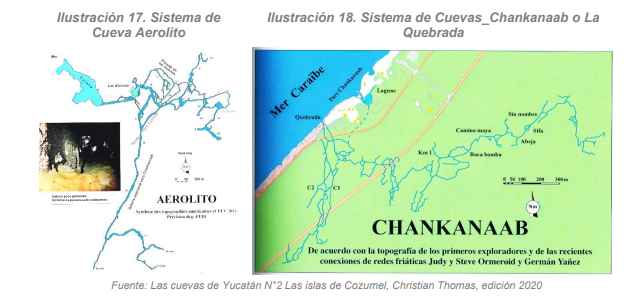Cozumel Island
PHYSICAL CHARACTERISTICS
1. Location and Biophysical Description.
1.1. Physiography.
1.2. Geomorphology.
1.3. Geology.
1.4. Edaphology.
1.5. Soil Type and Use.
1.6. Hydrology.
2. Climate.
3. Hydrology.
4. Caves and Caverns.
1. Location and Biophysical Description of the Basin.
Cozumel is a Mexican island, considered the third largest and the second most populous in the country. It measures approximately 48 km from north to south and 14.8 km from east to west. It is located nineteen kilometers off the coast, in the Caribbean Sea, sixty-two km south of Cancún, and constitutes (together with the continental enclaves Calica and Xel-Há) one of the 11 municipalities of the state of Quintana Roo. Its head and most populous city is San Miguel de Cozumel.
The municipality of Cozumel is located in the state of Quintana Roo and has an area of 48,808.11 hectares. Only 2.49% of the area belongs to the mainland. 97.50% of the municipality corresponds to Cozumel Island, which is located 17.5 km off the coast of Playa del Carmen City, northeast of the Yucatán Peninsula. Its extreme coordinates are: North 20 degrees 36', South 20 degrees 16' North latitude; East 86 degrees 44' and West 87 degrees 20' West longitude, making it the easternmost territory of Mexico, as reflected in the municipality's coat of arms by a sun rising on the horizon. It shares boundaries to the North and South with the Municipality of Solidaridad and the Caribbean Sea; to the East with the Caribbean Sea and to the West with the Municipality of Solidaridad.
Since March 19, 2016, it has been included by UNESCO as part of the World Network of Biosphere Reserves, this reserve includes both the terrestrial and marine portion. It is a flat island formed of limestone rock, the same that comes from the reefs. The most important natural elevation on the island is less than 16 meters above sea level.
Cenotes formed by the filtration of water through limestone for thousands of years can be explored by swimming or through activities such as snorkeling and cave diving; different marine species can be appreciated. The location of the population center is considered strategic for the regional urban system, since it constitutes one of the main nodes of the city system of the State of Quintana Roo, being one of the regional integrating centers.
1.1. Physiography.
According to the Municipal Program of Territorial, Ecological and Urban Development Planning of Cozumel, the percentages of surface established in the instrument were taken, and based on that, it is described that the Municipality of Cozumel is located in the Physiographic Province of the Yucatecan karst, which represents an area of 48,808.11 hectares (100%). Subprovince; of which Yucatecan Karst with an area of 48,725.14 hectares (99.83%) and Lower Coast of Quintana Roo with an area of 82.97 hectares (0.17%).
The cenotes, like the sinkholes, have a small morphology for their access in some cases; however, within the cave system, we can have great lengths in their horizontal development.
The landform system; Rocky plain with rocky or cemented floor with an area of 47,299.94 hectares (96.91%), Rocky plain with rocky or cemented floor with an area of 1,064.02 ha (2.18%), Not applicable 361.18 hectares (0.74%), and Beach or bar with rocky or cemented floor with an area of 82.97 ha (0.17%).
The probable origin of the island corresponds to a detachment from the eastern margin of the Peninsula during the formation of the Yucatán basin, between the Late Mesozoic and the Early Cenozoic. The island has a karstic topography, which causes the infiltration of rainwater, leading to the collapse of cave roofs and forming rocky depressions known as sinkholes or cenotes.
In Cozumel, both cenotes and sinkholes are small in size. In the area near Punta Sur, there are several cenotes and sinkholes in the jungle immediately north of Colombia Lagoon, as well as a small limestone plateau at Punta Celarain.
The karstic nature of the island prevents the formation of rivers on its surface since all rainwater filters through fractures and fissures in the terrain to the water table level; therefore, runoff towards the sea practically carries no suspended solids.
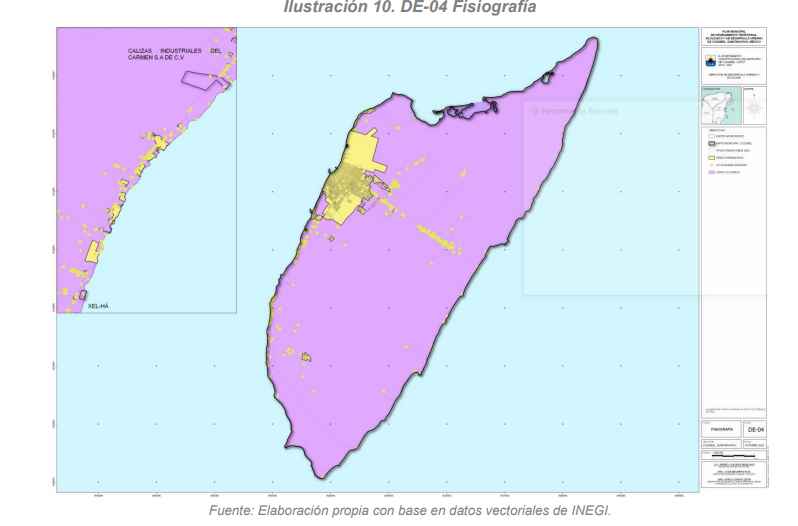
1.2. Geomorphology.
The geomorphology of Cozumel Island is represented in a single landform, which is the denudational karstic relief, karstic plain with incipient dolinization processes (39,789.3733 ha) (84.0766%), and three types of coasts are distinguished.
The flood and/or intertidal coast, located in the northern and southern areas of the island, are characterized by the presence of lagoon areas that have a direct connection to the sea, thus having a permanent dynamic of ebb and flow of tides. It covers an area of 4,740.1335 ha (10.0161%).
The biogenic coral reef coast is mainly located on the eastern coast of the island in two sites, on the central coast from Mezcalitos to Chen Río and on the northern coast covering the Reefs and the Royal Castle. On the western coast of the island, it occurs from La Caleta, La Ceiba, Dzul-Ha, and part of the Curvas de Tormentos area. It covers an area of 985.148 ha (2.0817%).
The undifferentiated coast with the beach is present on the eastern coast of the island on the southern coast from Chen Río to Playa Box and on the northern coast from Mezcalitos to the reefs. It covers an area of 1,810.4735 ha (3.8256%).
The land relief on Cozumel Island has evolved in the dynamics of the geographical cycle through a series of constructive and destructive processes that are permanently affected by the force mainly of the tides on its coasts and its trade winds, as well as the weathering it receives from different factors such as rainfall and, at times, from meteorological phenomena called tropical storms and hurricanes, which act as a balancer of the unevenness; that is, it causes elevated areas to tend to fall and fill the depressed areas. These processes cause the relief to go through different stages.
The relief is affected by both biotic and abiotic factors, of which those properly geographic are considered abiotic factors of exogenous origin, such as relief, soil, climate, and bodies of water.
The climate with its elements such as pressure, temperature, and winds. Surface water with the action of runoff, river, and marine action. Tides modifying the coastline. They are factors that aid in modeling, favoring erosive processes.
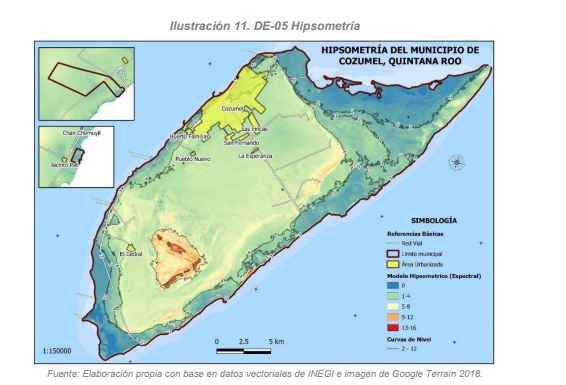
1.3. Geology.
The geological units of Cozumel Island are: The lacustrine Quaternary system Q(la) is found in the southern area of the island, covering from Palancar to Punta Celarían, comprising mangrove and lagoon areas. In the northern area of the island, this type of formation is also found, covering the area from Isla de la Pasión to Aguada Grande. This formation covers an area of 2,832.61 hectares (5.98%).
The littoral Quaternary system (Qli) is observed on the eastern coast of the island from Puntas Morena to the wetlands of Mezcalitos. It is also observed from Punta Arrecifes to Punta Molas. It covers an area of 1,242.93 hectares (2.61%).
The Tertiary Pliocene limestone system Tpl (cz) covering the central part of the island towards the western coast has an area of 27,352.61 hectares (57.81%).
The Upper Tertiary limestone system Ts (cz) has an area of 15,893.8008 hectares (33.58%).
The geology of Cozumel Island is similar to that found throughout the Yucatán Peninsula; studies conducted coincide in indicating sedimentation of the seabed from the Tertiary Era, on a basement of rocks from the Secondary Era, which has originated a gigantic slab that began to rise in pauses and setbacks until the end of the Cenozoic Era, continuing until today in the northern part. This slab consists of granular, crumbling, whitish limestone called sascab.
The most abundant rock in the entity is sedimentary, both from the Tertiary and Quaternary, both periods belonging to the Cenozoic Era (63 million years).
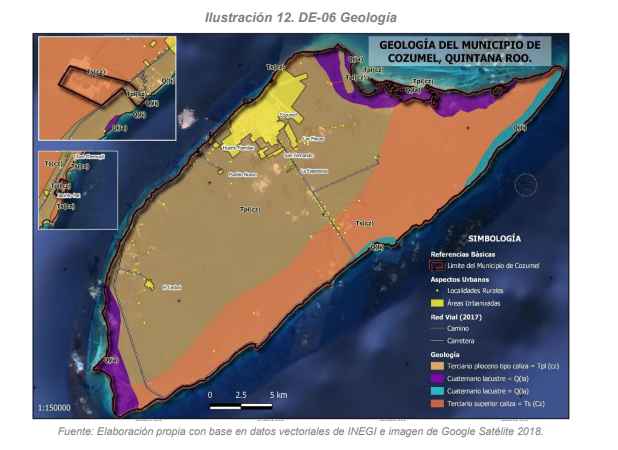
1.4. Edaphology.
On the island surface, five main groups of soils are distributed with very unequal extensions. The main one is Rendzina (currently Leptosol (LP) according to SICS ISRIC-FAO. 1999), which occupies an area of 33,404.99 hectares (70.59%) distributed throughout its central zone. Leptosol soils are limited in depth by a continuous and hard rock within 10 cm of the soil surface, presenting a profile of type A-R. They always appear in areas with steep slopes and/or places that have undergone intense erosion processes. Under these conditions, if the soil degradative process continues, these Leptosols can disappear, leading to widespread outcrops of the underlying rock, reaching a practically irreversible final state of degradation.
The second in coverage is Solonchak (SC), which occupies an area of 5,702.83 hectares (12.05%) of the territory and is distributed mainly in the swampy areas of the southern and northern ends and in a portion of the northeastern coast (being in the first case of orthic type and in the other two of gleic type). Solonchak soil is found on the strip of low lands and swamps of the marshy plain and can be differentiated by their relative contents of salts and organic matter.
The third is the soil called Gleysol (GL) (molic type), which occupies an area of 2,892.87 hectares (6.11%) of the island surface and is located on the eastern coast immediately north of the transversal highway.
Gleysol soils are poorly drained soils, presenting water in the profile, permanently or semi-permanently, with fluctuations in the water table level in the first 5 dm; the most abundant are humic and calcareous gleisols. They occur when relief conditions favor stagnation.
The fourth is the Arenosol soil (AR), which consists of soils with a sandy-loamy or coarser texture, occupying an area of 4,647.59 hectares (9.84%). They are characterized by their scant or nonexistent evolution and a practically undifferentiated profile with a thin A horizon, with very low incorporation of organic matter, on a sandy material totally loose and without any cohesion between its particles. They are highly permeable soils with little water retention capacity, resulting in plants being subjected to water stress. The high porosity of these soils results in great aeration ease favoring the oxidation and rapid mineralization of organic matter.
Another peculiarity of Arenosols is their great susceptibility to erosive processes, especially wind erosion, if they are not fixed by adequate vegetation cover, as occurs with the mobile dunes of the territory.
The Hortisol soil (ZU), are anthropogenic soils favorable for crop production. It occupies an area of 671.88 hectares (1.40%).
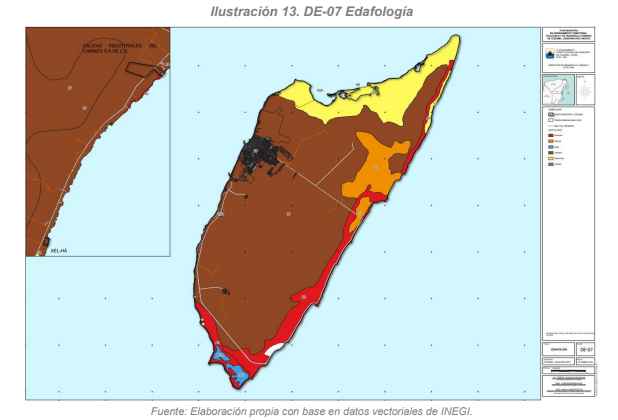
1.5. Soil Type and Use.
According to the set of vector data on land use and vegetation; INEGI Series VI. The Subperennial Medium Jungle is the one that occupies the largest area in the municipality with 34,239.63 hectares (70.15% of the total municipal). The uses that follow in importance are Mangrove with 4,753.15 ha (9.74%), Built Urban Soil with 3,104.40 hectares (6.18%), and Secondary Arboreal Vegetation of Subperennial Medium Jungle with 1,860.54 hectares (3.81%). The remaining 7.61% is composed of various land uses: cultivated grassland, water, tular, vegetation-free area, deciduous low jungle, apparent vegetation-free, coastal dune vegetation, secondary shrub vegetation of mangrove, and secondary shrub vegetation of subperennial medium jungle.
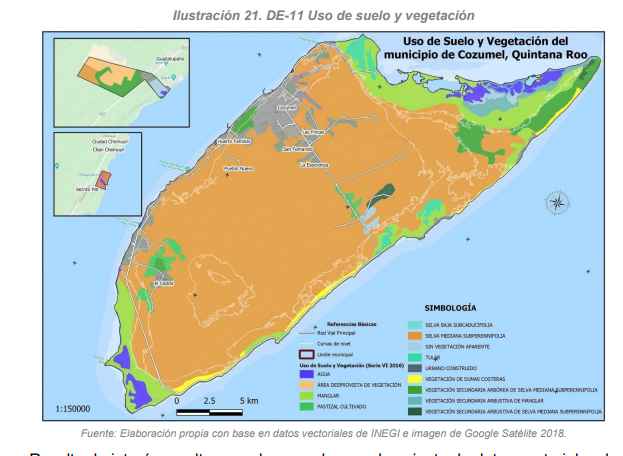
According to information from Series IV, agriculture exists in settlements such as ranches, where maize is cultivated on a small scale (Planted area 17 ha. 2009) and common species of fruit trees such as Soursop (Annona muricata), Avocado (Persea americana), Nanche (Byrsonima crassifolia), Papaya (Carica papaya), Coconut (Cocus nucifera), Guava (Psidium guajava), Tamarind (Tamarindus indica), Guaya (Talisia olivaeformis), Banana (Musa paradisiaca), among others. However, some of these ranches were already closed and abandoned due to legal issues. In the same vein, the livestock activity located in the northwest has decreased.
Out of the 48,808.11 hectares of the Cozumel municipality's surface area, 3,605 belong to the UGA CP1, intended for urban development, this surface area corresponds to 7.4% of the municipality. The polygon called Fundo Legal is considered the population center limit, of which approximately 74% is urbanized.
Of the urban area, 68% of human settlements are located within the Legal Fundo. 31% is located outside the population center limits, with the largest area corresponding to the AGEB where the Cozumel Airport is located.
However, buildings, mainly for hotel use, are also located along the northern coast, and towards the interior of the island, there are clusters of buildings, most of which are for residential use in irregular settlements. In total, the urban area is estimated at 2,399.70 hectares, which represents 4.92% of the island's surface area.
2. Climate.
The climate is classified as A w, (f) iw", hot humid rainy tropical with intense summer rains (Téllez et al. 1989). The annual precipitation is 1,607 mm (the month with the least precipitation is March with 44.1 mm and the month with the most precipitation is September with 241.6 mm). The average annual temperature is 25.5°C (the hottest months are July and August with 27.3°C and the coldest month is January with 22.9°C; García 1988). In Cozumel Island, hurricanes and so-called "nortes" are frequent factors, as they can be devastating, but also their rains help recharge the aquifer. Cozumel is exposed to this type of phenomenon because it is within the cyclonic trajectory zone of the Caribbean Sea (INE-SEMARNAP 1998).
The most recent hurricanes that hit Cozumel are Gilberto (1988), Roxana (1995), and Emily (2005), with Gilberto being especially devastating.
3. Hydrology
Groundwater. Due to the geological characteristics of the island, almost the entire subsurface is part of the aquifer. This is mainly contained in the Chankanaab and Abrigo formations as a single body of water that travels easily due to the porosity of these strata. Thus, the aquifer is formed by a large freshwater lens that floats due to its lower density over a saltwater one, meaning that most of the island should be considered as a free aquifer of phreatic waters (Lesser, 1978; CAPA, 2002).
It has an extension of 288 km2 (60% of the total island area), and the thickest sections are located in capture axes 2 and 3 north of the transversal road. The area of greatest recharge and thickness of the aquifer is the central zone. Then the water flows towards the coast through the subsurface radially until reaching the sea. This means that floodable areas are nourished by both direct rainfall water and water flowing from the aquifer to the coast, eventually mixing with marine influence.
The lagoon area to the north, along with the Laguna Colombia area, constitutes one of the largest flooding zones on the island, although there are also small temporary ponds in other parts.
Regarding the hydrogeochemical structure of the aquifer, the saline interface is found between 15 and 23 m in its central part, but the thickness of the freshwater lens decreases towards the coast, since the surface zone of groundwater in that area reaches values above 2.5 g/l of total dissolved solids. Considering these conditions, groundwater cannot be used for human consumption in that area without a prior desalination process. For this reason, exploitation wells are located in the central part, slightly to the northwest, where the thickness of freshwater is greater and has acceptable values of total dissolved solids for consumption.
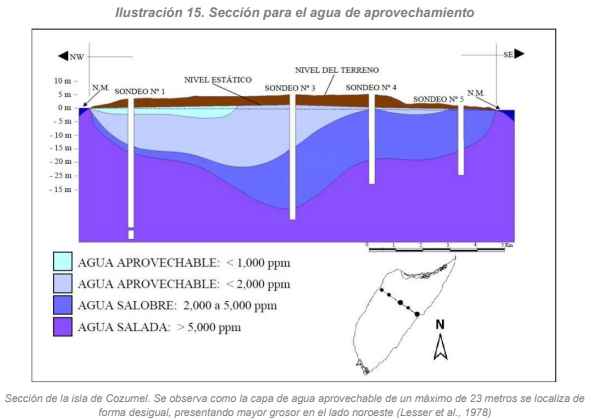
There are no significant perennial or intermittent rivers or streams on the island; this is due to the high karst content and the thin layer of surface soil, which facilitates the rapid absorption of rainwater into the subsurface.
However, this situation also favors underground hydraulic circulation, which has generated a system of cavities or caverns throughout the island, some of which emerge to the surface, in the so-called Sinks or Cenotes. A notable example of this type of formation is the cave of La Quebrada, at the southern end of the Chankanaab Natural Park, which has been explored 3 kilometers inside with scuba gear.
The island's aquifer can be represented in a profile as a horizontal ribbon beneath the island's surface and above sea level; it thins towards the coastal ends, being wider (approximately 5 m).
On the central wall of the island is where the main areas of infiltration and percolation of rainwater into the aquifer are located. Between freshwater and seawater is a mixing zone called the saline interface, where salinity increases with depth. In karst aquifers like that of Cozumel Island, this interface is usually abrupt with thicknesses of no more than 2 m.
However, despite the efficient surface drainage that exists in most of the island, we can find, close to the coast, some lagoons on areas where clay saturation in conjunction with outcropping rock has managed to reduce the rapid filtration of water; so many of these lagoons have temporary lives, disappearing in the critical months of drought. However, others are permanent because they are very close to the coast; examples of this are Laguna Colombia, Laguna Ciega, and Laguna de Montecristo.
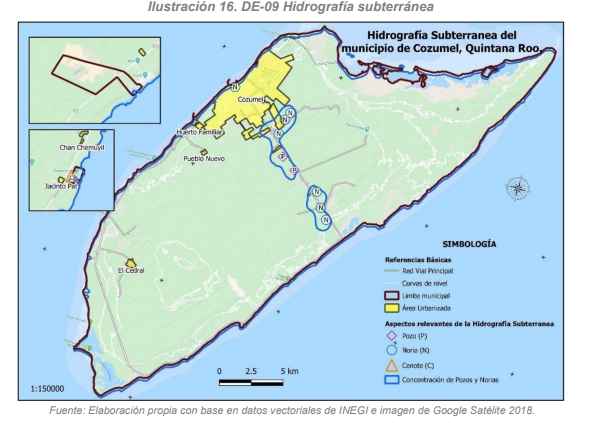
4. Caves and Caverns.
The Yucatan Peninsula has an interesting wealth of underground geomorphology; these formations have difficult access. Francisco Solís Marín, a researcher at the Institute of Marine Sciences and Limnology of UNAM, has studied organisms that live in anchialine caves on Cozumel Island, in the Mexican Caribbean, and affirms that the "fauna is fascinating"; organisms living in these caves have adapted to feed on and obtain energy from microbial mats that form on the walls and ceiling of the cave, such as the starfish (Copidaster cavernícola) found by speleologist Germán Yáñez in the cave called "El Aerolito", located west of Cozumel Island.
In Cozumel, 180 subsurface entrances have been recorded, of which 50% contain water or are completely flooded, while others are completely dry, including margin flank caves located in the paleodune surrounding the island. The biodiversity that inhabits them is high, with great specialization and strategies to survive in extreme environments, and most species are endemic.
Recently, endemic species of microcrustaceans have been found in flooded caves on the island, where their closest congeners have been found in other parts of the world, highlighting the importance of caring for these environments, not only for their present species but as ecosystems of great relevance to the island.
